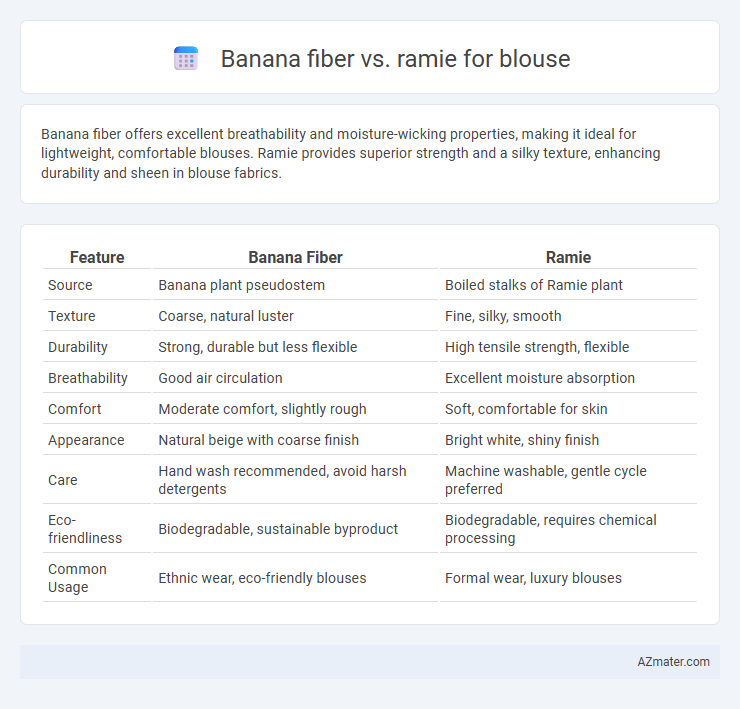Banana fiber offers excellent breathability and moisture-wicking properties, making it ideal for lightweight, comfortable blouses. Ramie provides superior strength and a silky texture, enhancing durability and sheen in blouse fabrics.
Table of Comparison
| Feature | Banana Fiber | Ramie |
|---|---|---|
| Source | Banana plant pseudostem | Boiled stalks of Ramie plant |
| Texture | Coarse, natural luster | Fine, silky, smooth |
| Durability | Strong, durable but less flexible | High tensile strength, flexible |
| Breathability | Good air circulation | Excellent moisture absorption |
| Comfort | Moderate comfort, slightly rough | Soft, comfortable for skin |
| Appearance | Natural beige with coarse finish | Bright white, shiny finish |
| Care | Hand wash recommended, avoid harsh detergents | Machine washable, gentle cycle preferred |
| Eco-friendliness | Biodegradable, sustainable byproduct | Biodegradable, requires chemical processing |
| Common Usage | Ethnic wear, eco-friendly blouses | Formal wear, luxury blouses |
Introduction to Banana Fiber and Ramie
Banana fiber, derived from the pseudostem of banana plants, is a strong, biodegradable natural fiber known for its durability and moisture-wicking properties, making it ideal for lightweight, breathable blouses. Ramie, sourced from the stalks of the Chinese nettle plant, offers a lustrous finish and excellent moisture absorption, contributing to smooth, comfortable fabric with high tensile strength. Both fibers excel in sustainability and comfort, but banana fiber emphasizes eco-friendly strength, while ramie highlights silky texture and durability.
Overview of Banana Fiber: Characteristics and Source
Banana fiber, derived from the pseudostem of the banana plant (Musa species), is a strong, biodegradable natural fiber known for its lightweight and breathable properties, making it ideal for blouse fabrics. It features a coarse texture that softens with processing and natural moisture-wicking capabilities, promoting comfort in warm climates. The sustainable extraction from banana stems supports eco-friendly textile production by utilizing agricultural waste and reducing environmental impact.
Understanding Ramie: Origins and Key Properties
Ramie, a natural bast fiber derived from the stalks of the Chinese nettle plant, is highly valued for its strength, durability, and lustrous appearance, making it a preferred choice for blouse fabric. Unlike banana fiber, which has a coarser texture, ramie offers a smooth, silky feel that enhances comfort and breathability in warm climates. Its excellent moisture absorption and resistance to bacterial growth contribute to long-lasting, easy-care blouses suitable for both casual and formal wear.
Environmental Impact: Banana Fiber vs. Ramie
Banana fiber offers a sustainable advantage due to its use of agricultural waste, requiring minimal chemical processing and generating lower carbon emissions compared to Ramie. Ramie, while biodegradable and durable, involves energy-intensive retting and degumming processes that contribute to higher water pollution and chemical use. Choosing banana fiber for blouses supports eco-friendly fashion by reducing environmental footprint throughout the production cycle.
Comfort and Wearability in Blouses
Banana fiber offers excellent breathability and moisture-wicking properties, making it highly comfortable for blouses in warm climates. Ramie, known for its smooth texture and durability, provides a crisp appearance but may be less flexible and slightly rougher compared to banana fiber. Both fibers contribute to wearability, with banana fiber excelling in softness and ramie delivering structure and resilience for long-lasting blouses.
Durability and Longevity Comparison
Banana fiber offers moderate durability with natural moisture-wicking properties, making it suitable for casual blouses but prone to wear over time due to its coarser texture. Ramie, a bast fiber derived from the nettle family, boasts superior tensile strength and resistance to bacteria, resulting in longer-lasting blouses that maintain shape and color even after multiple washes. For enhanced blouse longevity, ramie's resistance to pilling and its ability to blend with other fibers provides a durable, sustainable alternative to banana fiber.
Breathability and Moisture Management
Banana fiber boasts exceptional breathability due to its natural porous structure, allowing air to circulate freely and keep the skin cool, making it ideal for lightweight blouses. Ramie, while also breathable, offers superior moisture-wicking properties that effectively draw sweat away from the body, ensuring a dry and comfortable wearing experience. Both fibers enhance moisture management, but Banana fiber excels in ventilation, whereas Ramie provides better absorption and quick drying for optimal comfort.
Style Versatility and Aesthetic Appeal
Banana fiber offers a natural, textured look with excellent breathability, making it ideal for casual and eco-conscious blouse styles. Ramie, known for its silk-like sheen and smooth finish, enhances blouse designs with a polished, sophisticated aesthetic suitable for formal wear. Both fibers provide unique style versatility, with banana fiber emphasizing rustic charm and ramie delivering elegant drape and luster.
Cost and Market Availability
Banana fiber offers a cost-effective option for blouses with prices typically lower than ramie due to its abundant availability in tropical regions and simpler extraction process. Ramie, while more expensive, is valued for its silky texture and durability, but faces limited market availability because it requires specialized processing and is grown in fewer regions. Manufacturers often weigh banana fiber's affordability against ramie's premium quality when selecting materials for blouse production.
Choosing the Best Fiber for Blouses: Final Thoughts
Banana fiber offers a lightweight, breathable texture ideal for summer blouses, providing natural moisture-wicking and durability, while ramie excels with its silky sheen, wrinkle resistance, and antibacterial properties, enhancing comfort and longevity in everyday wear. When choosing the best fiber for blouses, consider factors like climate suitability, fabric care, and desired aesthetic; banana fiber suits eco-friendly, casual styles, whereas ramie complements more polished, formal designs. Prioritizing personal comfort and maintenance preferences ensures selecting a blouse fabric that combines sustainability with practical wearability.

Infographic: Banana fiber vs Ramie for Blouse
 azmater.com
azmater.com